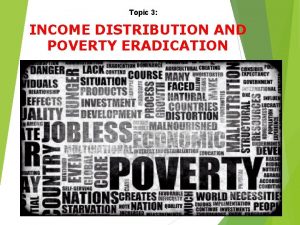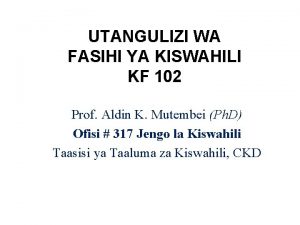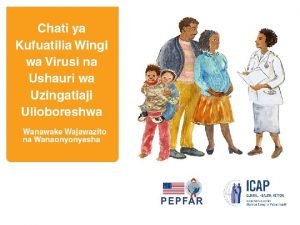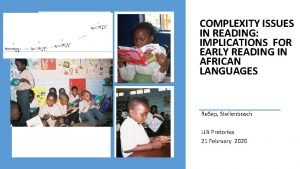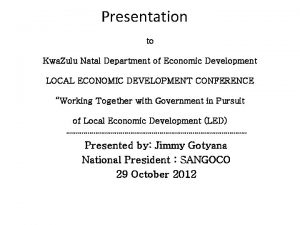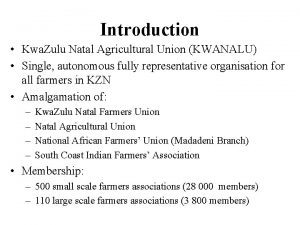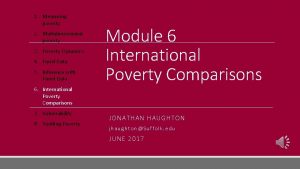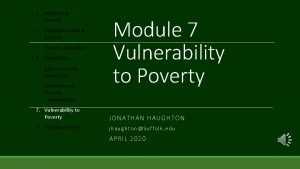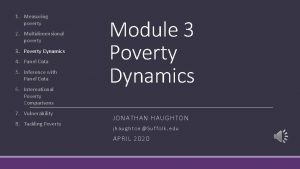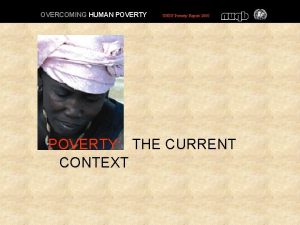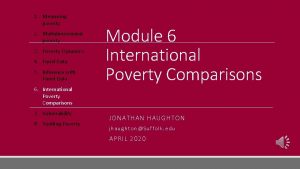InterGenerational Transfer of Household Poverty in Kwa Zulu




















- Slides: 20

Inter-Generational Transfer of Household Poverty in Kwa. Zulu Natal: Evidence from KIDS (1993 – 2004) Antonie Pool University of the Free State TIPS Conference, Cape Town October 2008

Outline of paper p Literature review p Data p Methods p Results p Conclusion and policy recommendations

Background & Literature Poverty alleviation is focus of many policy frameworks (MDG’s, ASGISA) MDG’s ½ poverty by 2015 ASGISA ½ poverty by 2014 56% of Africans & 15% of Indians still live in poverty (UNDP, 2004) Poverty = when a person/household cannot attain a reasonable minimum level of economic wellbeing (Ravallion, 1994). Require knowledge of poverty determinants to achieve goal of halving poverty by 2014 Problem is the existence of poverty traps 60% of SA’s poor households are caught in a structural poverty trap (Carter & May, 2001) Inter-generational-transfer of poverty also a poverty trap

Aims of the study p What determines the poverty status of a Dynasty household? p What influence does the background (transitions) of a household have on the probability to be poor? (IGT poverty) p What can be done to ensure the goal of halving poverty by 2014 is reached – given the regression results?

Data p Kwa-Zulu Natal Income Dynamics Study (KIDS) data Longitudinal survey following a random sample of individuals who lived in KZN in 1993. p Survey done in 3 waves n 1993 , 1998, 2004 n In 1998 & 2004, only re-interviewed Africans & Indians p 2004 Due to aging & effect of HIV/AIDS n Include Next Generation & Foster households p Study focuses on all these wave To look at the determinants of poverty in Dynasty households and the role of Core characteristics.

Method p Divided 2004 data between “core” & “dynasty” households n Where dynasty households represent the split-off “next generation” & ”foster” households of the core households

Method - continue p Income Poverty All those households that fall below the pre -defined poverty line n Poverty line = R 250 p/person per month (2000 prices) (Van der Berg & Louw, 2004) n Used CPI to inflate poverty line to 1993, 1998 & 2004 value n Used adult equivalent household sizes n Compared household poverty line based on household expenditure

Method - continue p Regression analyses Firstly used Panel data to determine dynamic variables, followed by a cross sectional Probit model estimation n Indicate the effect of each independent variable on the probability that a Dynasty household is poor (HHSize = 0. 05 For every 1 additional member in the hh, the probability to be poor increases by 5%) n This identify the distinction of core dynamics versus dynasty characteristics as the main determinants of poverty

Household level of poverty Difference between 2004 dynasty- & 1993 core households significant at 10% level of significance. Differences between 2004 dynasty- & both the 1998 & 2004 core households significant at 1% level of significance.

Levels of education (1993 Core & 2004 Dynasty)

Poverty status of core households (1993 -2004)

Regression Analyses - The model

Regression Results – Dynasty Characteristics * 10% level of significance; **5% level of significance; *** 1% level of significance

Regression Results – Core Characteristics * 10% level of significance; **5% level of significance; *** 1% level of significance

Regression Results – Pooled models * 10% level of significance; **5% level of significance; *** 1% level of significance

Regression Results – Intergenerational Transfer of Poverty (ITP) (Poverty | X) (d. F/dx) hhsize_Dynasty 0. 0302 ** Dependants_Dynasty 0. 0350 * Transitory. Poor 0. 1487 *** Chronically. Poor 0. 4131 *** Obs 446 Wald chi 2 53. 29 (0. 0000) Pseudo R 2 0. 2056 Correctly classified 80. 04% Std. errors adjusted for clusters 276 * 10% level of significance; **5% level of significance; *** 1% level of significance

Regression Results – Intergenerational Transfer of Poverty (ITP) (Poverty | X) (d. F/dx) No. School_Dynasty 0. 0771 *** Primary_Dynasty 0. 0430 *** Secondary_Dynasty 0. 0074 Matric_Dynasty 0. 0149 Post. Secondary_Dynas ty 0. 1436 ** Transitory. Poor 0. 1134 ** Chronically. Poor 0. 3239 *** Obs 446 Wald chi 2 75. 73 (0. 0000) Pseudo R 2 0. 2537 Correctly classified 81. 17% Std. errors adjusted for clusters 276 * 10% level of significance; **5% level of significance; *** 1% level of significance

Conclusion & Policy recommendations p Household size and the number of dependants in a household have an influence on the probability that a household will be poor. p Surprisingly, employment income has only a small impact on the probability that a household will be poor (Remittance income influence larger) (Maybe due to educational and unemployment profile of group) p Background & change over time (especially in the level of education) play a determinant role in the poverty status of a household p Most important determinant of household poverty is intergenerationally transferred – poverty trap that needs ultimate attention p Those households exposed to IGT poverty – Long-term problem. In these cases, the most important focus must be on education.

Further research: p Interact core/dynasty characteristics to explain why dynasty/core households escaped poverty or not? p The role of migration and net-remittances in poverty.

Thank You
 Intergenerational conflict in the workplace
Intergenerational conflict in the workplace Types of poverty
Types of poverty Bei ya kahawa tanzania
Bei ya kahawa tanzania Dhana ya fasihi na chimbuko lake
Dhana ya fasihi na chimbuko lake Kufanya kaz za kuinama kwa mama mjamzito ni sahihi
Kufanya kaz za kuinama kwa mama mjamzito ni sahihi Common household chores method of heat transfer
Common household chores method of heat transfer Izibonelo izigaba zamabizo 1 to 15
Izibonelo izigaba zamabizo 1 to 15 Military time 11:00
Military time 11:00 Zen zulu
Zen zulu Aileron snatch
Aileron snatch The zulu girl roy campbell
The zulu girl roy campbell Zulu words with ndlw
Zulu words with ndlw Informal letter in zulu
Informal letter in zulu Class concordance in zulu
Class concordance in zulu The birth of shaka poem sound devices
The birth of shaka poem sound devices Zulu prdiction
Zulu prdiction Gamet aviation definition
Gamet aviation definition God in zulu
God in zulu Cato zulu industrial park
Cato zulu industrial park Presentation in zulu
Presentation in zulu Fuso orario +12
Fuso orario +12

